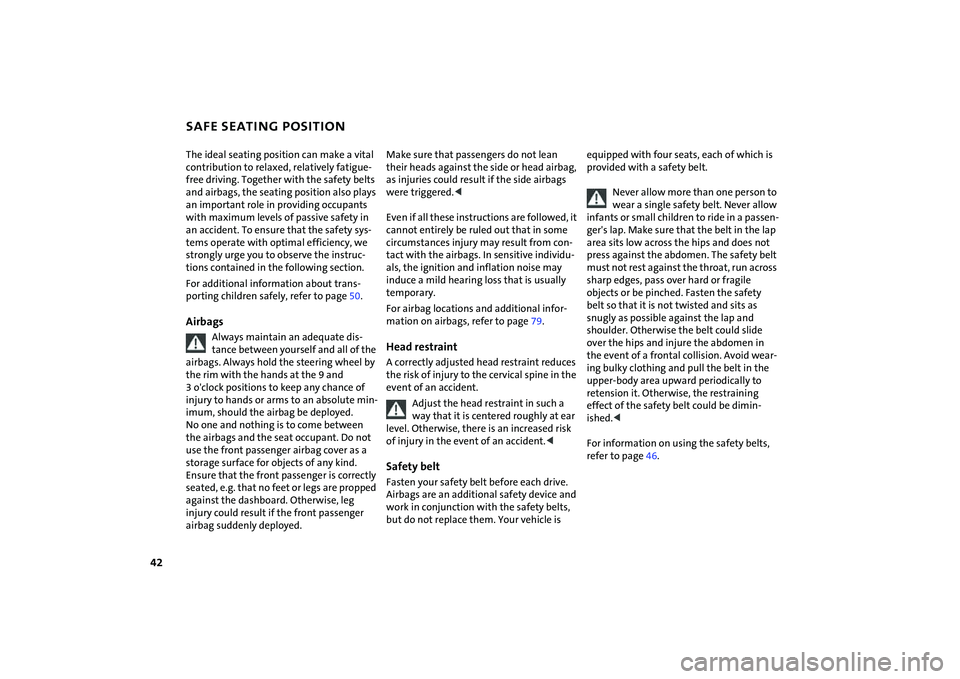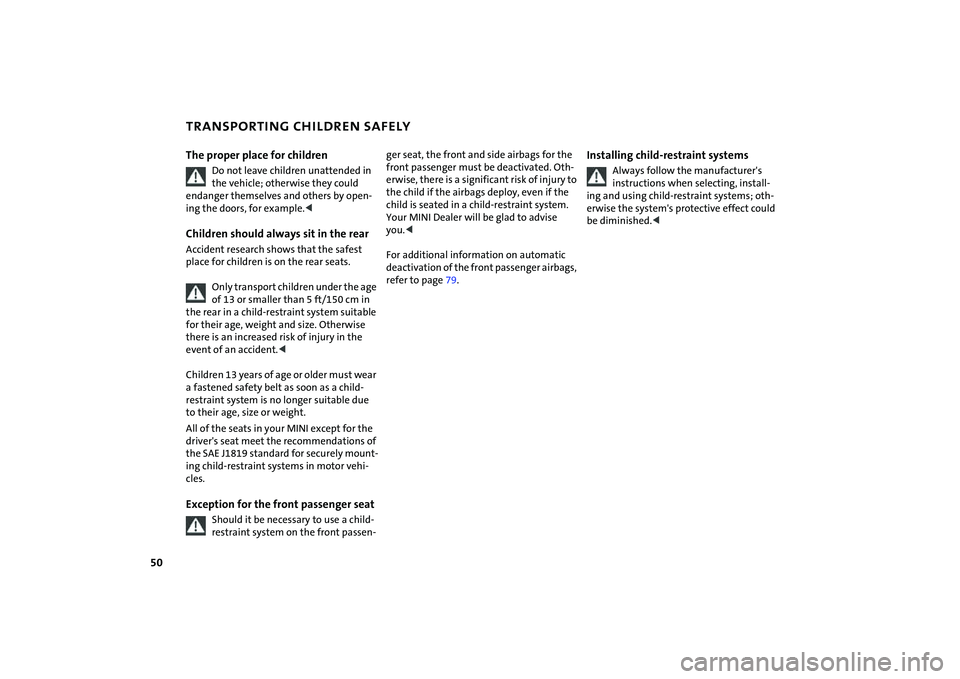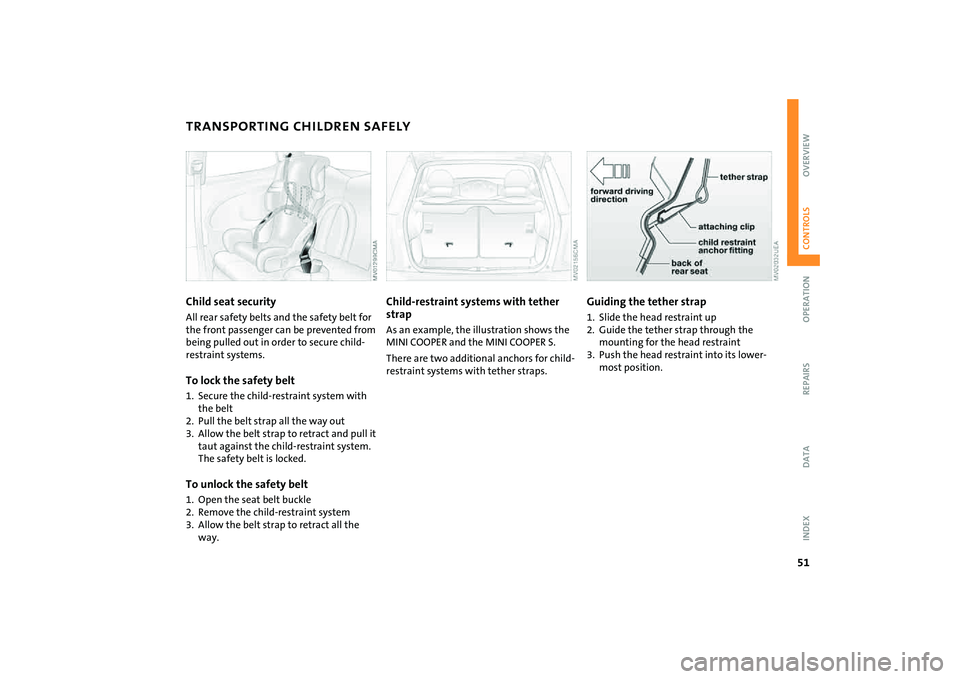2008 MINI COOPER CONVERTIBLE child seat
[x] Cancel search: child seatPage 4 of 176

CONTENTS
2
© 2007 Bayerische Motoren Werke
Aktiengesellschaft
Munich, Germany
Reprinting, including excerpts, only with the
written consent of BMW AG, Munich.
Order No. 01 41 0 014 845
US English VIII/07
Printed in Germany
Printed on environmentally friendly paper,
bleached without chlorine, suitable for recycling.NOTES About this Owner's Manual 6
Additional sources of information 6
Symbols used 6
Your individual vehicle 6
Editorial notice 7
For your own safety 7
Symbol on vehicle parts 8
Service and warranty 8
Reporting safety defects 9
OVERVIEWCockpit 12
Display elements 13
Display elements with navigation system
or Cockpit Chrono Pack14
Indicator and warning lamps 16
Multifunction steering wheel20
CONTROLSOpening and closing:
Keys 24
Central locking system 24
Opening and closing: from outside 25
Opening and closing: from inside 28
Tailgate 29
Electric power windows 31
Glass sunroof, electric33
Roller sun blind34
Convertible top with integrated sliding
sunroof 35
Wind deflector39
Adjustments:
Safe seating position 42
Seat adjustment 43
Head restraints 44
Entry to the rear 45
Safety belts 46
Seat heating47
Steering wheel 47
Mirrors 48
Vehicle Memory 49
Transporting children safely 50
Page 44 of 176

42
SAFE SEATING POSITIONThe ideal seating position can make a vital
contribution to relaxed, relatively fatigue-
free driving. Together with the safety belts
and airbags, the seating position also plays
an important role in providing occupants
with maximum levels of passive safety in
an accident. To ensure that the safety sys-
tems operate with optimal efficiency, we
strongly urge you to observe the instruc-
tions contained in the following section.
For additional information about trans-
porting children safely, refer to page50.Airbags
Always maintain an adequate dis-
tance between yourself and all of the
airbags. Always hold the steering wheel by
the rim with the hands at the 9 and
3 o'clock positions to keep any chance of
injury to hands or arms to an absolute min-
imum, should the airbag be deployed.
No one and nothing is to come between
the airbags and the seat occupant. Do not
use the front passenger airbag cover as a
storage surface for objects of any kind.
Ensure that the front passenger is correctly
seated, e.g. that no feet or legs are propped
against the dashboard. Otherwise, leg
injury could result if the front passenger
airbag suddenly deployed.
Make sure that passengers do not lean
their heads against the side or head airbag,
as injuries could result if the side airbags
were triggered.<
Even if all these instructions are followed, it
cannot entirely be ruled out that in some
circumstances injury may result from con-
tact with the airbags. In sensitive individu-
als, the ignition and inflation noise may
induce a mild hearing loss that is usually
temporary.
For airbag locations and additional infor-
mation on airbags, refer to page79.Head restraintA correctly adjusted head restraint reduces
the risk of injury to the cervical spine in the
event of an accident.
Adjust the head restraint in such a
way that it is centered roughly at ear
level. Otherwise, there is an increased risk
of injury in the event of an accident.
work in conjunction with the safety belts,
but do not replace them. Your vehicle is
equipped with four seats, each of which is
provided with a safety belt.
Never allow more than one person to
wear a single safety belt. Never allow
infants or small children to ride in a passen-
ger's lap. Make sure that the belt in the lap
area sits low across the hips and does not
press against the abdomen. The safety belt
must not rest against the throat, run across
sharp edges, pass over hard or fragile
objects or be pinched. Fasten the safety
belt so that it is not twisted and sits as
snugly as possible against the lap and
shoulder. Otherwise the belt could slide
over the hips and injure the abdomen in
the event of a frontal collision. Avoid wear-
ing bulky clothing and pull the belt in the
upper-body area upward periodically to
retension it. Otherwise, the restraining
effect of the safety belt could be dimin-
ished.<
For information on using the safety belts,
refer to page46.
Page 52 of 176

50
TRANSPORTING CHILDREN SAFELY The proper place for children
Do not leave children unattended in
the vehicle; otherwise they could
endanger themselves and others by open-
ing the doors, for example.<
Children should always sit in the rearAccident research shows that the safest
place for children is on the rear seats.
Only transport children under the age
of 13 or smaller than 5 ft/150 cm in
the rear in a child-restraint system suitable
for their age, weight and size. Otherwise
there is an increased risk of injury in the
event of an accident.<
Children 13 years of age or older must wear
a fastened safety belt as soon as a child-
restraint system is no longer suitable due
to their age, size or weight.
All of the seats in your MINI except for the
driver's seat meet the recommendations of
the SAE J1819 standard for securely mount-
ing child-restraint systems in motor vehi-
cles.Exception for the front passenger seat
Should it be necessary to use a child-
restraint system on the front passen-
ger seat, the front and side airbags for the
front passenger must be deactivated. Oth-
erwise, there is a significant risk of injury to
the child if the airbags deploy, even if the
child is seated in a child-restraint system.
Your MINI Dealer will be glad to advise
you.<
For additional information on automatic
deactivation of the front passenger airbags,
refer to page79.
Installing child-restraint systems
Always follow the manufacturer's
instructions when selecting, install-
ing and using child-restraint systems; oth-
erwise the system's protective effect could
be diminished.<
Page 53 of 176

51
OVERVIEW REPAIRS OPERATIONCONTROLS DATA INDEX
TRANSPORTING CHILDREN SAFELYChild seat securityAll rear safety belts and the safety belt for
the front passenger can be prevented from
being pulled out in order to secure child-
restraint systems.To lock the safety belt1. Secure the child-restraint system with
the belt
2. Pull the belt strap all the way out
3. Allow the belt strap to retract and pull it
taut against the child-restraint system.
The safety belt is locked.To unlock the safety belt1. Open the seat belt buckle
2. Remove the child-restraint system
3. Allow the belt strap to retract all the
way.
Child-restraint systems with tether
strapAs an example, the illustration shows the
MINI COOPER and the MINI COOPER S.
There are two additional anchors for child-
restraint systems with tether straps.
Guiding the tether strap1. Slide the head restraint up
2. Guide the tether strap through the
mounting for the head restraint
3. Push the head restraint into its lower-
most position.
Page 82 of 176

80
AIRBAGStivated or activated, refer to Functional sta-
tus of the front passenger airbags below. <
Before transporting a child on the
front passenger seat, read the safety
notes and instructions under Transporting
children safely, refer to page50.
Adolescents and adults sitting in certain
positions could also deactivate the front
and side airbags for the front passenger;
the indicator lamp for the front passenger
airbags comes on. In such cases, the occu-
pant should change his or her sitting posi-
tion so that the front passenger airbags are
activated and the indicator lamp goes out.
If the airbags are not activated although
the seat occupant has changed his or her
position, have the occupant sit on a rear
seat. Do not attach covers, cushions, ball
mats or other items to the front passenger
seat unless they are specifically recom-
mended by the manufacturer of your MINI.
Do not place any objects under the seat
which could press against the seat from
below. Otherwise, a correct analysis of the
seat cushion is not ensured.<
Functional status of the front
passenger airbagsAs an example, the illustration shows the
indicator lamp for front passenger airbags
in the MINI Convertible.
In accordance with whether and how the
front passenger seat is occupied, the indi-
cator lamp for the front passenger airbags
shows the functional status of the front
and side airbags for the front passenger.
The indicator lamp shows whether the
front passenger airbags are activated or
deactivated.
>The indicator lamp comes on as intended
when a child in a specially designated
child-restraint system is detected on the
front passenger's seat.
The front and side airbags for the front
passenger are not activated.
>The indicator lamp does not come on
when the system detects a person of suf-
ficient size sitting correctly on the seat,
for example. The front and side airbags
for the front passenger are activated.
>The indicator lamp does not come on
when the seat is empty. However, the
front and side airbags for the front pas-
senger are not activated. Operational readiness of the airbag
system
Starting from ignition key
position 1, the warning lamp in the
display elements lights up briefly
for confirmation that the entire airbag sys-
tem and the seat belt tensioners are opera-
tional.
Airbag system malfunctioning>The warning lamp does not come on
along with ignition key position 1
>The warning lamp stays lit continuously.
In the event of a malfunction, have
the airbag system checked immedi-
ately. Otherwise, there is a risk that the sys-
tem will not function as intended in an
accident of sufficient severity.<
Page 163 of 176

EVERYTHING FROM A TO Z
161
OVERVIEW REPAIRS OPERATION CONTROLS DATA INDEX
Brake pads103
break-in procedures102
warning lamp18
Brakes124
ABS72
brake fluid124
brake pads103
break-in procedures102
CBC72
indicator/warning
lamps16
,17,18
parking brake54
Brake system124
brake fluid124
brake pads103
break-in procedures102
disc brakes103
warning lamp17
Brake wear warning
brake pads103
warning lamp18
Breaking in102
Bulb replacement, refer to
Lamps and bulbs133
Buttons on multifunction
steering wheel20
automatic transmission with
Steptronic58C
California Proposition 65
warning7
Capacities157
Car care, refer to Caring for your
vehicle126
Car-care products126
Care, vehicle126
Care of plastics127
Care of synthetic leather127
Cargo area
opening from the outside29
opening with the remote
control26
volume155
,156
Cargo area, refer to Luggage
compartment in the MINI93
Cargo area cover, refer to
Luggage compartment
cover93
Car keys, refer to Keys24
Carpet care128
Car radio, refer to separate
Owner's Manual
Car telephone, refer to separate
Owner's Manual
Car vacuum cleaner,
connecting, refer to Cigarette
lighter socket90
Car wash126Car wash, refer to Washing
your vehicle126
Cassette operation, refer to
Owner's Manual for Radio
Catalytic converter, refer to
Hot exhaust system104
CBC Cornering Brake Control72
CD changer, refer to Owner's
Manual for Radio
CD operation, refer to
Owner's Manual for Radio
Center armrest89
Central locking system24
interior28
Changing bulbs133
Changing the wiper
blades132
,133
Changing tires139
space-saver spare tire137
Charge-current indicator
light16
Children, transporting50
Child-restraint fixing system,
LATCH52
Child-restraint systems50
Child seat, refer to Installing
child-restraint systems50
Chock, folding
space-saver spare tire137
Chrome parts, refer to Caring
for your vehicle127Chrome-plated parts, care127
Cigarette lighter90
Cigarette lighter socket90
Cigarette tray, refer to
Ashtray89
Circulation of air, refer to
Recirculated air mode83
,86
Cleaning the rear window64
Cleaning the vehicle, refer to
Caring for your vehicle126
Clock67
12-hour/24-hour mode67
changing the time67
Closing
from inside28
from outside25
Clothes hooks104
Clutch53
break-in procedures102
Cockpit12
Coding, tires112
Cold start, refer to Starting the
engine53
Compact disk operation, refer
to Owner's Manual for Radio
Compartments, refer to
Storage compartments88
Computer, refer to Onboard
computer70
Condensed water, refer to Air
conditioning83
,86
Page 170 of 176

EVERYTHING FROM A TO Z
168
Remote control key, refer to
Master keys with remote
control24
Replacement key24
Replacement of tires
changing tires137
new wheels and tires116
Reporting safety defects9
Reserve indicator light, refer to
Fuel gauge67
,68
Reservoir, washing systems64
Reservoir for washer fluid64
Restraint systems
for children50
refer to Safety belts46
Retaining straps97
Reverse
automatic transmission with
Steptronic56
manual transmission55
Rod antenna127
Roller sun blind34
Roof load, refer to
Weights155,156
Roof-mounted luggage rack98
Rope, refer to Towing and Tow-
starting148
RSC Runflat System
Component, refer to
Run-Flat Tires115Runflat System Component
RSC, refer to Run-Flat
Tires115
Run-Flat Tires115
puncture114
replacing116
tire inflation pressure109
winter tires116
S
Safety belt height
adjustment46
Safety belts46
care128
height adjustment46
indicator lamp17
,46
reminder46
safe seating position42
Safety lock buttons, doors,
refer to Locking28
Safety systems, refer to
Airbags79
All Season traction Control
(ASC)72
Antilock Brake System
(ABS)72
Brake system72
Dynamic Stability Control
(DSC)72
Safety tires, refer to
Run-Flat Tires115Seat adjustment43
Seat-belt tensioner, refer to
Safety belts47
Seat heating47
Seats
heating47
safe seating position42
Securing loads, refer to Loading
cargo95
Securing the load97
Securing the vehicle
from inside28
from outside26
Selector lever, automatic
transmission with
Steptronic56
Selector lever positions,
automatic transmission with
Steptronic56
Selector lever shiftlock, refer to
Shiftlock56
Service and Warranty
Information Booklet for US
models, Warranty and
Service Guide Booklet for
Canadian models125
Service interval display69
,125
Shifting gears in the automatic
transmission with
Steptronic58Shiftlock, refer to Range
selection56
Shift paddles58
Side airbags79
Side turn signal indicators, bulb
replacement135
Signal horn, refer to Horn12
Sitting safely42
with airbags42
with head restraints42
with safety belt42
Slipstream deflector, refer to
Wind deflector39
Smoker's equipment package,
refer to Ashtray89
Snow chains117
Socket 12 V90
Socket for
onboard diagnostics126
Socket in the luggage
compartment90
Space-saver spare tire
changing tires137
inflation pressure109
Spare key24
Spare tire, refer to Space-saver
spare tire137
Special oils, refer to Specified
engine oils122
Special wash program126
Specified oils122